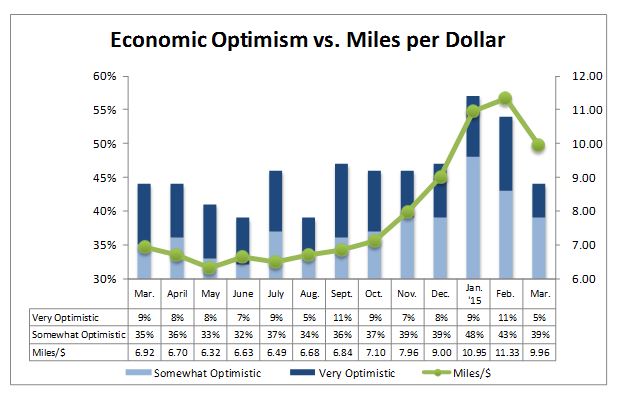ALEXANDRIA – Rising gas prices are taking a toll on consumer optimism about the economy, with optimism falling to its lowest level since August 2014. Consumer optimism fell from 54% to 44%, the largest decrease in optimism in more than two years, according to survey results released by NACS.
In the past month, gas prices rose 29 cents per gallon, as refineries have begun the transition to produce the costlier summer-blend fuels that are required in many markets across the country. Over the past 15 years, gas prices have increased, on average, more than 50 cents per gallon during the February-to-May transition.
Consumers expect the upward trajectory of gas prices to continue, as three in four (73%) believe gas prices will be higher in 30 days than they are today — a noteworthy increase from 58% in February. Weather may also play a role, with consumer optimism the lowest in the Northeast (37%), which has been battered by storms and cold weather this past month.
“While prices are rising, retail gross margins on gas are falling and now average 10 cents per gallon, about half of the 19 cents per gallon that they have averaged over the past five years,” said NACS Vice President of Strategic Industry Initiatives Jeff Lenard. “After factoring in expenses — especially credit card fees — profit margins across the country are slim or negative at the fuel pump now.”
With gas prices rising, consumers say they are more sensitive to the price at which they would change their behavior. The median fuel price consumers say they would try to reduce how much they drive is $3.50 per gallon, down from $4.00 this time last year. Similarly, the median price that consumers would seek out alternatives to drive is $4.14 per gallon, down from $4.70 in March 2014. Both of these figures are the lowest since NACS initiated the monthly consumer survey in January 2013.
“This lowering of the price threshold would seem to give evidence to the theory that consumers become much more sensitive to a spike after a period of lower prices,” said Lenard. “Consumer optimism has fallen to the level of August 2014, when gas prices were $3.50 a gallon, more than a dollar a gallon more than today.”
There is some good news in the findings. Despite the rise in gas prices, nearly one in five (19%) consumers say that they will spend more money on consumer goods over the next 30 days, the highest level since December when holiday shopping surged.
Younger consumers are most likely to spend and drive more this month. Of those ages 18-34, 27% say that they will shop more this month and 28% say that they will drive more, significantly higher than the overall average of 17%.
Over the past five months, consumer optimism has closely tracked miles per dollar spent on fuel, which measures self-reported fuel efficiency and gas prices.
